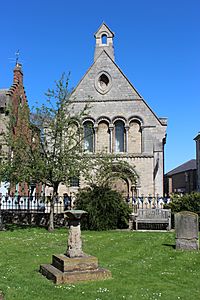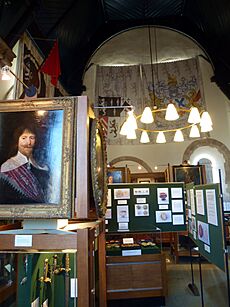Cromwell Museum facts for kids

The west front of the Cromwell Museum, Huntingdon. The building retains features from the medieval Hospital of St John's.
|
|
| Established | 1962 |
|---|---|
| Location | Huntingdon, Cambridgeshire |
| Type | Biographical |
The Cromwell Museum in Huntingdon, England, is a special place. It holds many items that tell the story of Oliver Cromwell. He was a very important person in English history. His son, Richard Cromwell, is also mentioned. Oliver Cromwell was born in Huntingdon in 1599. He lived there for more than half his life. The museum is in the old school building where Cromwell himself studied. It opened in 1962. The museum has important objects, paintings, and old papers. These items are from the time when Cromwell was in charge of England. This period was called The Protectorate. Today, a special trust helps run the museum. This trust works to share Oliver Cromwell's history.
Contents
The Museum Building
The Cromwell Museum is inside a very old building. It used to be a grammar school. Both Oliver Cromwell and the famous diarist Samuel Pepys went to school here. The building still has parts from a medieval hospital. This hospital was called the Hospital of St John the Baptist. It was built around 1170-1190. It was a place that helped poor people.
From Hospital to School
The hospital was founded by David of Scotland, Earl of Huntingdon. It followed rules from a group called the Augustinians. The hospital masters were chosen by the town's leaders. In 1547, the hospital building became Huntingdon Grammar School. The school stayed there until 1896. It later moved to Hinchingbrooke House.
Building Changes Over Time
The building was changed a lot when it was a school. It was rebuilt and fixed up in 1863. Then, in 1878, it was restored again. This work cost £900. It was paid for by a writer named Dion Boucicault. He did this to remember his son. His son had died in a train accident in 1876. During the work, old brick was taken off the building. Workers found a blocked Romanesque doorway. This is a type of old archway. The building also has a bell tower. It has five fancy arches on its front. It is now a Grade II* listed building. This means it is a very important historic building.
How the Museum Started
In 1958, there was a temporary exhibit in Huntingdon. It marked the anniversary of Cromwell's death. After this, the local council decided to create a collection. They wanted to celebrate the town's most famous person. The empty grammar school building was a good spot for a museum. The Cromwell Museum opened in 1962. It had been decorated inside. At first, the local council managed it. From 2016, a special charity trust took over running the museum.
Museum Collections
The Cromwell Museum has the best collection of "Cromwelliana" in the UK. "Cromwelliana" means items connected to Oliver Cromwell. In 2009, it had about 610 different items. The museum owns most of these items. Some items are on loan from other places. These include items from Cromwell's family. There are also 17th-century military items from the Royal Armouries. The Museum of London also loaned some objects.
Portraits and Medals
The museum has many paintings of Cromwell and his family. Two of these are by Robert Walker. There is also a copy of a famous portrait by Sir Peter Lely. This painting shows Cromwell "warts, and everything." There is also a later painting of Cromwell by Edward Mascall. The museum has small, detailed paintings called miniatures. These are in the style of Samuel Cooper. You can also see old coins from Cromwell's time. There are also several special medals. One is a copy of the Lord Protector medal.
Personal Items and Documents
The museum displays unique objects. These were passed down through Cromwell's family. One is a hat that Cromwell might have worn. He might have worn it when he closed the Long Parliament in 1653. Another item is his personal powder flask. This was used to carry gunpowder. The museum also has a special cabinet that belonged to Cromwell. It was used by a person who made medicines. There is also a fancy cabinet from Florence. The Duke of Tuscany gave it to Cromwell.
Most official papers about Cromwell are kept in The National Archives. But the museum has many old printed papers. It also has copies of important texts from that time. One example is The Humble Petition & Advice from 1657. This paper explained how Parliament worked. It also described the duties of the Lord Protector. The Cromwell Collection is in the nearby Huntingdon Library. It has one of the best collections about Oliver Cromwell outside of universities. This collection is free to use. It was started in 2002 with help from a grant.
Museum Management
The museum was once thought to be closing. This was part of the local council's budget plans for 2015–2016. They thought it would save £20,000 a year. But on April 1, 2016, a charity trust took over running the museum. This trust now manages the museum.
Images for kids
-
Model of spital that preceded the Grammar School. Arches support the nave, giving access to the now-demolished side buildings. Only the left-hand end of the nave (with two arched bays) survives.





